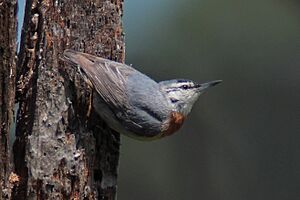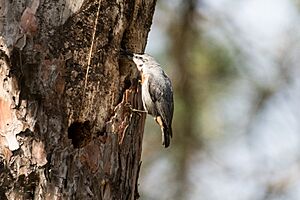Krüper's nuthatch facts for kids
Quick facts for kids Krüper's nuthatch |
|
|---|---|
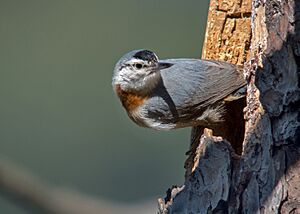 |
|
| Male in a pine forest on the island of Lesbos, Greece. | |
| Conservation status | |
| Scientific classification | |
| Genus: |
Sitta
|
| Species: |
krueperi
|
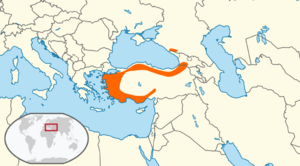 |
|
| Distribution of the Krüper's nuthatch | |
| Synonyms | |
|
• Sitta krüperi (Pelzeln, 1863) |
|
The Krüper's nuthatch (Sitta krueperi) is a small bird that belongs to the nuthatch family. It is about 12.5 centimetres (4.9 in) long. This bird has blue-gray feathers on its back. Its head has a black cap, which is a bit lighter on females. It also has a black stripe across its eye and a bright white stripe above it.
The Krüper's nuthatch eats insects in the summer. In fall and winter, it mostly eats seeds, especially from pine trees. These birds build their nests in tree holes. They usually lay five to seven eggs. The female sits on the eggs, and the male brings her food. Both parents help feed the baby birds.
You can find the Krüper's nuthatch in pine and other coniferous forests. They live in Turkey, on the island of Lesbos, and in the Caucasus mountains. They often live where Turkish pine trees grow. These birds can be found from sea level up to 2,500 metres (8,200 ft) high. Sadly, their homes are shrinking because of logging and new buildings for tourists. Even though their numbers are going down, experts say they are of "least concern" for now.
Contents
Meet the Krüper's Nuthatch: What's in a Name?
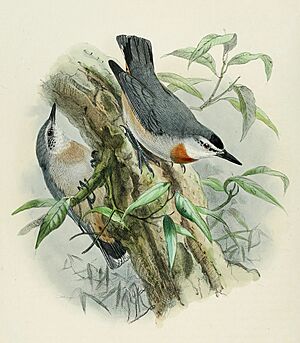
The Krüper's nuthatch got its name in 1863. An Austrian bird expert, August von Pelzeln, named it Sitta krüperi. He named it after the German bird expert Theobald Johannes Krüper. Krüper was the person who first found this bird.
Scientists group birds into families and types. The Krüper's nuthatch is part of a group of small nuthatches. It is very similar to the Algerian nuthatch. These two birds are the only ones with a black cap on the front of their heads.
Family Tree: How Birds Are Related
Scientists use special tests to figure out how birds are related. They look at the birds' DNA. This helps them build a "family tree" for different species.
In 1998, a scientist named Éric Pasquet studied the DNA of ten nuthatch species. He found that the Krüper's nuthatch is closely related to the Algerian nuthatch. These two birds are like sisters in the nuthatch family. Later, in 2014, more studies confirmed this. They also found that the Yunnan nuthatch is the oldest relative in this group.
These findings match how the birds look. For example, the red-breasted nuthatch, Corsican nuthatch, and Chinese nuthatch all have a fully black cap, but only the males. The Krüper's and Algerian nuthatches have a black cap only on the front of their heads. Young birds don't have this black cap yet.
| Nuthatch family tree according to Pasquet, et al. (2014): | |||||||||||||||||||||||||||||||||
|---|---|---|---|---|---|---|---|---|---|---|---|---|---|---|---|---|---|---|---|---|---|---|---|---|---|---|---|---|---|---|---|---|---|
|
What Does a Krüper's Nuthatch Look Like?
The Krüper's nuthatch is a small to medium-sized bird. It is about 12.5 centimetres (4.9 in) long. Males are a bit bigger than females. Males weigh about 10–14.3 grams (0.35–0.50 oz).
Its back feathers are blue-gray. Both male and female adults have a black cap on the front of their heads. The wings are gray-brown. It has a white stripe above its eye. Below that is a black stripe that goes across its eye. Its throat is white. The rest of its belly is light gray. It has a big, reddish patch on its chest shaped like a crescent moon. Its eyes are dark brown. Its beak is dark gray, and its legs are gray-brown.
Spotting the Differences: Males, Females, and Young Birds
It can be a bit tricky to tell male and female Krüper's nuthatches apart. Females have a black cap that is less clear than the male's. Their belly feathers are also paler and more buff-colored. Males have a pure gray belly.
Young Krüper's nuthatches are easier to spot. Their feathers are duller. They don't have the black cap that adults do. Their reddish chest patch is also very faint.
Life and Habits of the Krüper's Nuthatch
Krüper's nuthatches usually live alone or in pairs. During the time they raise their young, the family stays together. In the fall, you might see them in small groups of two to five birds. Sometimes, they join other kinds of birds to look for food.
Bird Calls: What Do They Sound Like?
The Krüper's nuthatch is a loud bird. You can often hear its calls. Its contact call sounds like "dvui" or "dui-dui-dui-dui". When it's upset, it makes a rough "èèhch" sound. Its song is a "tuituituituitui…" sound that goes up and down.
What Do Krüper's Nuthatches Eat?
This nuthatch is very active. It looks for food high up in trees, on small branches. It can also find food in bushes or even on the ground. In spring and summer, it mainly eats insects. When insects are harder to find in fall and winter, it eats seeds from pine and other cone-bearing trees.
It picks insects off branches or catches them in the air. It pulls seeds from pine cones with its beak. Then, it wedges the seed into a crack in the tree bark and hammers it open. Krüper's nuthatches also hide food. This helps them when pine cones close up and seeds are hard to get.
Reproduction and Life Cycle
The Krüper's nuthatch breeding season is from mid-March to mid-May in Turkey. The exact time depends on where they live and how high up it is. They usually have only one group of babies each year.
Their nests are often in holes in conifer trees, high off the ground. They often use holes that are already there. The female cleans out the hole. Sometimes, they can dig their own hole in dead trees. The nest is lined with bark, rotten wood, and pine cone scales. They also add moss, hair, wool, and feathers.
The female lays four to seven eggs, usually five or six. The eggs are creamy white with small red or purple spots. The female sits on the eggs for 12 to 17 days. The male brings her food while she is on the nest. Both parents help feed the baby birds. The young birds mainly eat beetles, insect larvae, and earthworms. On average, four young birds leave the nest when they are 15 to 19 days old.
Tiny Invaders: Parasites
Like many animals, Krüper's nuthatches can have tiny living things called protists in their blood. These are a type of parasite. Scientists found these parasites in some Krüper's nuthatches in Turkey.
Where Do Krüper's Nuthatches Live?
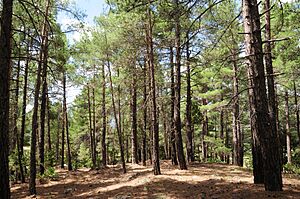
The Krüper's nuthatch mostly lives in Turkey. It is common in western Turkey. It also lives along the Mediterranean coast in the Taurus Mountains. You can find it along the Black Sea coast up to southern Georgia. It also lives on the Greek island of Lesbos. Sometimes, it visits mainland Greece.
This bird loves Turkish pine trees. Its home range almost perfectly matches where these trees grow. Krüper's nuthatches usually stay in one place. But after they raise their young, some birds might move a little. Some young birds might move to lower areas in winter. They might go to mixed forests or forests with trees that lose their leaves.
Krüper's nuthatches live in cool conifer forests. They can be found from sea level up to about 2,500 meters high. In Turkey, they mostly live between 1,000 and 1,600 meters. They live in forests with Turkish pine, Caucasian spruce, Nordmann fir, Cilician fir, black pine, and cedar of Lebanon. At higher places, they might live among junipers.
Protecting the Krüper's Nuthatch
The Krüper's nuthatch is common in Turkey, but there are fewer of them in the Caucasus. On Lesbos island, their numbers seem steady. However, their homes are being destroyed by fires and logging.
In Turkey, new laws for tourism have made things harder for the bird. It's easier to build hotels and summer homes along the coast. This takes away the forests where the nuthatches used to live. Losing their woodland homes is a big problem for them.
In 2014, there were an estimated 80,000 to 170,000 pairs of Krüper's nuthatches. This means about 240,000 to 510,000 birds in total. Their numbers are going down. Because of this, the International Union for the Conservation of Nature first said the species was "near threatened". But in 2015, new numbers showed that the population was not dropping as fast as thought. So, the species is now listed as "least concern". This means they are not in immediate danger of disappearing.



